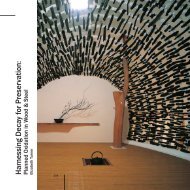Construction History: Between Technological and Cultural History
Construction History: Between Technological and Cultural History
Construction History: Between Technological and Cultural History
You also want an ePaper? Increase the reach of your titles
YUMPU automatically turns print PDFs into web optimized ePapers that Google loves.
Antoine Picon<strong>Construction</strong> historyThis tension between the speculative <strong>and</strong> the factual is of course not a monopolyof construction history. It is, however, especially pronounced in the field. Itcontributes to give it a special flavor that is not to be found in other fields. But atthe same time it reinforces the relative isolation of construction history within thelarger realm of history of technology.Are the features I have been evoking, from the enduring presence of professionalconcerns to the tension between the speculative <strong>and</strong> the factual, a good ora bad thing? They certainly represent a challenge since they contribute to make thedomain somewhat special. But they are at the same time full of opportunities, asI will try to show at the end of this presentation.But before returning to this question, I would like to discuss the relationsbetween construction history <strong>and</strong> cultural history.1.4~,. sull~n .1 1/ 6 ; 0wnghlui!ding In Saint~ouis, detail of thedt' 0 ratlon.<strong>Construction</strong> history <strong>and</strong> cultural historyThese relations are by no means less complex than those that exist betweenconstruction history <strong>and</strong> history of technology. What can construction historyteach us regarding the culture of a given society, if one chooses to define culture asthe system of shared values, representations <strong>and</strong> practices that make collective lifepossible?For the nineteenth-century pioneers of the domain, these relations were selfevident.For instance, Viollet-le-Duc saw Gothic as intimately linked to medievalurban culture. In his eyes, Gothic architecture was first inseparable from civicconcerns. Cathedrals were supposed to serve these civic concerns by enablinggatherings. For the author of the Dictionnaire raisonne, the thin ribbed vault wasthe direct consequence of the high cost of materials <strong>and</strong> labor that characterizedurban life. Its ribbed structure implied the use of flying buttresses with the rigorof a mathematical theorem corollary. The lancet arch enabled a st<strong>and</strong>ardization ofstone cutting, again in accordance with the cost of materials <strong>and</strong> labor. Finally,Gothic was far more than a structural principle. It was a mode of reasoning, anattitude towards life that epitomized what was truly essential <strong>and</strong> , by the sametoken, modern in medieval urban life. In almost Hegelian fashion, it was becauseof these deep roots in the culture of its time that Gothic could be considered as auniversal model. Incidentally, Viollet-le-Duc did not advocate the direct transpositionof Gothic forms to nineteenth-century architecture. He was never a fullyfledged neo-Gothic architect. What he wanted was to capture the fundamentalspirit of adaptation to the condition of the time that according to him characterizedGothic architecture; hence his attempt at transposing the Gothic lesson to moderncast iron construction in his Lectures on Architecture.In Viollet-le-Duc's writings, just as in Semper's, construction problems wereinseparable from ornamental ones, the latter being also in close contact with thecultural practices of their time. Hence the parallel between the Egyptian capital<strong>and</strong> Egyptian hairstyle that was self-evident for Semper.The belief that construction represents indeed a privileged expression of culture<strong>and</strong> that it is often linked to ornamental issues was to remain present until theend of the nineteenth century. For instance, it permeated Louis Sullivan's approachto the skyscraper problem. For him, the skyscraper was both a question of thesteel frame, as exemplified by Le Baron Jenney's pioneering realizations like theFair Store Building, <strong>and</strong> a problem of ornament,9 Both were eminently cultural.Both had to express the dynamic spirit of the time through constructive rigor as wellas through the rhythmic quality of the ornamentation. This is among others themessage carried by a masterpiece like his Wainwright Building in Saint Louis(1891) (Figure 1.4).We are still convinced by those kinds of links when dealing with traditionalsocieties <strong>and</strong> vernacular construction techniques. We have no difficulty, forinstance, in relating the structure of the South Algerian M'Zab cities to the cultureof the people who have built them. 10 19






